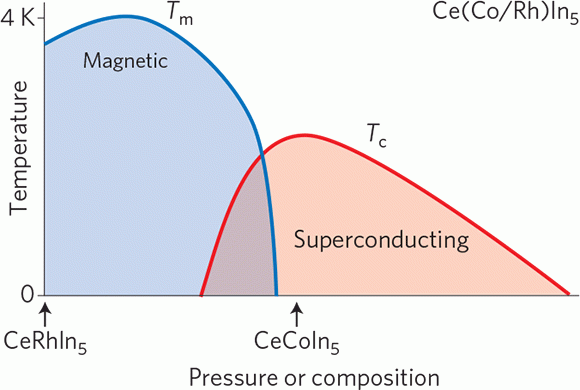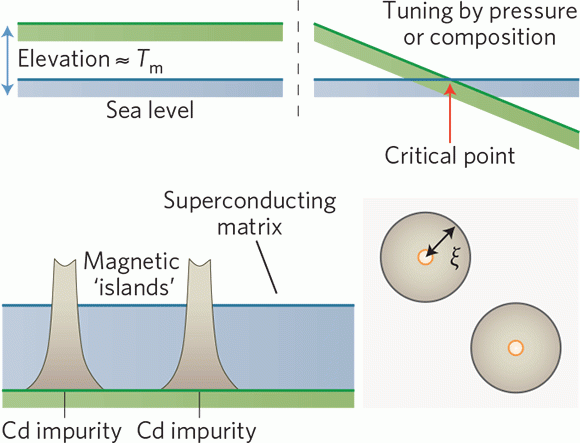Discoveries in condensed matter physics are frequently found on the verge of magnetic order at low temperature. Examples include unconventional superconductivity in the high-temperature cuprate and iron pnictide superconductors, the electronic nematic state in Sr3Ru2O7 and the breakdown of the standard theory of metals — Fermi liquid theory — in YbRh2Si2. Because the threshold of magnetism is reached at low temperature by tuning intrinsic material properties rather than by thermal fluctuations, it is called a quantum phase transition or, if the magnetic transition remains second-order, a quantum critical point. The effects of disorder, which are particularly pertinent if magnetism is reached by chemical substitution or doping, are often neglected. Writing in Nature Physics, Soonbeom Seo and collaborators demonstrate that doping-induced disorder can lead to an inhomogeneous magnetic quantum phase transition that is fundamentally distinct from the more commonly explored spatially homogeneous scenario.

Figure 1 | Schematic phase diagram of the Ce(Co/Rh)In5 system in zero applied field. CeRhIn5 is antiferromagnetic at low temperature, but applying pressure or doping with Co drives it into a non-magnetic superconducting state. In contrast, CeCoIn5 is non-magnetic and superconducting, but doping with Rh makes it magnetic. The present study explores whether crossing into the magnetic state from CeCoIn5 by substituting Cd for In works in the same way.
Seo et al. have investigated the superconductor CeCoIn5, which, like a number of related rare-earth-based materials, features ultra-narrow energy bands near the chemical potential. CeCoIn5 and isoelectronic CeRhIn5 are positioned on either side of a magnetic quantum phase transition, enabling detailed studies of quantum criticality and superconductivity in metals (Fig. 1). In the present work, the authors tuned CeCoIn5 across the threshold of magnetism by chemical substitution of In by Cd. An earlier investigation had demonstrated that replacing about 10% of In in CeCoIn5 with Cd induces robust magnetic order at low temperature, which can be removed again by applying hydrostatic pressure. By reducing Cd doping levels tenfold, the present study homes in on the immediate vicinity of the quantum phase transition. The latest results suggest that even 1% Cd doping is sufficient to induce magnetic order in CeCoIn5, but that the magnetic transition has an unexpected character: at low temperature Cd impurities nucleate magnetic regions, which are separated by pristine CeCoIn5, leading to a highly inhomogeneous magnetic state when the Cd concentration is low.

Figure 2 | Routes to induce magnetism in metals. Upper panel: Illustrating the magnetic ordering temperature Tm as elevation above sea level. Non-magnetic material corresponds to submerged areas, whereas high magnetic-ordering temperatures correspond to mountain ranges. The critical point occurs when Tm goes to zero smoothly. This can be achieved by tuning the material composition or by changing external parameters such as pressure or magnetic field. The fertile ‘mudflats’ close to the critical point give rise to numerous interesting correlated states in narrow-band metals. Lower panel: Seo et al. argue that Cd impurities in CeCoIn5 nucleate spatially confined magnetic regions, analogous to volcanic islands rising from the deep sea. The magnetic correlation length ξ sets the length scale over which Tm can vary and thereby defines the island size. Long-range magnetic order sets in if the correlation length exceeds the distance between the Cd atoms.
Figure 2 illustrates the fundamental difference between the conventional tuning approach and the mechanism put forward by Seo et al. as operating in Cd-doped CeCoIn5. The magnetic ordering temperature Tm varies over intermediate length-scales, and is analogous to the elevation of a land mass compared with sea level. CeCoIn5 corresponds to a flat land mass just submerged, whereas CeRhIn5 can be pictured as a highland plateau. By changing the water level, corresponding to applying pressure or varying the ratio of Co to Rh, one can be tuned into the other. Substitution of In by Cd in CeCoIn5, however, locally elevates Tm over a tightly defined region around each Cd site, creating the analogue of a volcanic island. The resulting heterogeneous material will not necessarily develop long-range magnetic order, but this will occur eventually if the separation between the islands becomes less than their size.

